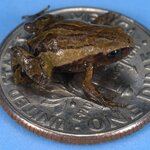Ecology & Zoology

That question, specifically, is: "What if a cuttlefish attacked an octopus?"
And the answer can be found here. It's a pretty amazing video.

"Wash that for you?" If you were a fish living in the warm turquoise waters off the coast of Bonaire, you may not hear those words, but you'd see the shrimp sign language equivalent. It seems Periclimenes yucatanicus or Spotted Cleaner Shrimp is doing a booming business in the local reefs by setting up a fish washing service.
That's right, a Fish Wash. You'd be hard pressed to find a terrestrial Molly Maid with two opposable thumbs as studious and hardworking as this wee marine beauty.
This quiet marine mogel is turning out to be one of the ocean's top entrepreneurs. Keeping its host and…

Dave Cooper’s pet mantis, Cinco Zapatos, was a good-looking Giant African Mantis with a notable distinguishing feature: her sixth leg was missing. It didn’t seem to hamper her much. Her first weeks as Dave’s insect familiar were uneventful until Dave returned from a three-day trip to find that Cinco Zapatos had molted—and had become Seis Zapatos in the process. Cinco Zapatos had regrown most of her leg.
Though it’s a shock for us to witness, the loss and regain of a limb is no big deal to a young insect. Bugs lose legs and antennae in fights, flights, accidents, or…

Scorpions possess resistance to high temperatures and the ability to conserve water for long periods of time, and as a result thrive in hot and arid parts of the world. But is this global distribution also seen at a more local level? Doctoral student Shmuel Raz and colleagues at the University of Haifa, Israel show that this is indeed the case, even when European-like and African-like habitats were separated by no more than 100 meters.
Shmuel Raz and colleagues studied the communities of scorpions in a valley near Mount Carmel in Israel which has been dubbed "Evolution Canyon."…

It fits on a fingertip: Noblella pygmaea is a midget frog, the smallest ever found in the Andes and among the smallest amphibians in the world. Only its croaking was to be heard from the leaves on the mossier ground of the “elfin forests” in the highlands of Manu National Park, before German and Peruvian herpetologists discovered the tiny little thing in south-eastern Peru.
The popular name of the new species is fitting: Noble’s Pygmy Frog has an average length of 11.4 millimeters. It was introduced in a paper recently published in the journal Copeia by Edgar Lehr, a German…

Remember when Bugs Bunny dressed as Brunhilda to mess with opera viking Elmer Fudd? If the What's Opera, Doc? ended with Bugs biting off half of Elmer Fudd’s head to keep him hanging around as an immobile food source, then the "Kill The Wabbit" cartoon would essentially tell the story of the Spotted Predatory Katydid. This bug-of-prey lures lovesick male cicadas by decoding the complex cicada mating duet and imitating a lusty cicada female. As soon as the male cicada gets in grabbing range, the duet becomes a lot less romantic.
The male cicada’s mating aria is impossible to imitate. Each…

An international team of scientists has discovered a new acarine species (Ophionyssus schreibericolus) that lives off black green lizards from the Iberian Peninsula. This involves the first recording of the Ophionyssus genus that feeds off and lives on animals endemic to the peninsula. The researchers now think that these parasites could be found in other reptiles in the region.
The new acarine species is an ectoparasite that belongs to the Macronyssidae (Mesostigmata) family. The interest in this finding lies in the animal that pays host to this parasite, namely the black green lizard (…

Welcome to what has become Inadvertent Cicada Week in this column. Obviously, I'm fascinated by them. This started around the summer of 2003, when I was completely addicted to a certain farm-simulator game for the Nintendo SP.
During virtual summer on my virtual farm the game's music was overpowered by a jarring REEEREEEREEEREEEEEEE sound, intended to represent Japan’s singing cicadas. When I finally managed to turn my Gameboy off to get some good ol’ grad student day-sleep in the relative stillness of central Pennsylvania, I found that the REEEREEEEEEEE noise had…

Butterflies seem able to both attract mates and ward off predators using different sides of their wings, according to new research in the journal Proceedings of the Royal Society B: Biological Sciences. Trying to find the balance between these two crucial behaviors is one of nature’s oldest dilemmas, according to Jeffrey Oliver, a postdoctoral associate in Yale’s Department of Ecology and Evolutionary Biology and lead author on the study.
Oliver was interested in whether the eyespots on the upperside of butterflies’ wings – specifically, those of bush brown butterflies – serve a…

If you don't know the story of the cane toads, here's the short version: imported to Australia in hopes of controlling the cane beetle, which came to the continent with the sugar cane when *it* was imported (are you sensing an unfortunate pattern here?), they now run amok and wreak havoc on natural Australian ecosystems. It's one of the best invasive species horror stories that I know.
(side note: possibly the best thing to come out of this tragedy is the documentary, "Cane Toads: An Unnatural History", which you should see IMMEDIATELY if for some reason you haven't. Priceless.…